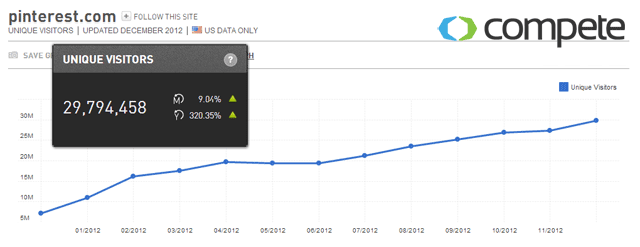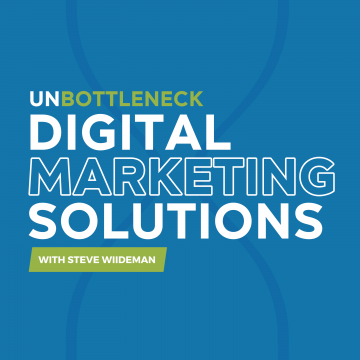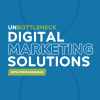There is a lot of hype at the moment about Pinterest and it’s visual approach to social media and web-surfing. Today I’m going to discuss the growth of visual social networking, the potential value of Pinterest, and share an interview I was fortunately to get with a technology company that has figured out how to track revenue against images posted online (even off your website) – skip to the interview video here.
Visual Social Networking
As a marketer, I try to keep up with what’s hot in terms of advertising platforms. I’ve watched the mighty jump and ugly belly-flop of client attempts to make Facebook Ads a viable revenue source (to be fair, some retailers such as Threadless have nailed it). I’ve also seen B2B clients shift AdWords budget to LinkedIn Ads and still struggle with hitting cost-per-acquisition goals.
So when a free advertising medium presents itself, you can bet I (and the inbound marketing community) are the first ones to figure out how to optimize placement, rank, and conversion. After all, what’s the point in advertising anywhere if you’re not able to measure it’s impact to the bottom line, right?
For the last several years we’ve watched the evolution of social networks like Tumblr go from micro-blog to image-blog. We’ve watched Twitter add image upload features, Facebook image-tagging has gotten smarter, and even Google+ has jumped in with instant uploads of mobile device images to Google+ galleries. Heck, now you can send pictures to Tumblr, Facebook, Foursquare and other social sites with your Instagram mobile app (which, yes, has become it’s own social network as well – powered by Facebook).
Images are taking off, perhaps with even greater interest than video, since videos need to be paused, stopped, browser-friendly, sound-friendly (if in a work environment) and have other limitations, where images render seamlessly on any browser, device, or any circumstance. They are fast, funny, and, yes, worth a thousand words.
Enter Pinterest
For those with an interest in pinning (posting) and viewing images, there’s Pinterest, a new viral social network that’s taking the Web by storm.
Check Out Pinterest Traffic Stats in 2012 – Wow!

My first question after getting my special invite last year was, “how the heck do I make money with this thing?” (thinking on behalf of my clients who I know will ask). Without a second thought, in comes Social Media Examiner Writer and Pinterest Authority Melanie Duncan and flood of emails promoting what might be the best Pinterest marketing training available online: The Power of Pinning.
I paid for the program and sent my login details to one of my assistants in Manila to create a Cliff Notes & checklist version for me (I mean really, who has 20 hours to watch videos in today’s economy?).
My resource got so excited about what we watched that he shared it with another member of the team, and well, long story short, my entire team and a few others managed to get me banned from Melanie’s training for too many login attempts (if you’re reading this Melanie, I hope you can forgive me?).
Watch Melanie’s free webinar (no affiliate link here folks) if you’re not on the same page with me about how important Pinterest has actually become, and how businesses are monetizing the visual web: http://www.powerofpinning.com/webinar
Making Money from Image Marketing
Prior to a life-altering call I had with Liz Madsen of Curalate, my impression of Pinterest (as an SEO) was that it is “a way to get a strong backlink for boosting search rankings” – nothing more. But what I learned was that Pinterest is actually making up for a major percentage of traffic and sales among retailers such as H&M, Walmart and many others.
Case studies are popping up all over the place, including this one from Econsultancy reverse-engineering Walmart’s social media strategies. Liz shared several awesome examples and articles proving that pinning is positively profitable (say that three times backwards), including Forbes and their post appropriately titled Now There Is No Reason For A Brand Not To Be On Pinterest.
Promotional Techniques
Below is a list of techniques actively used by retailers and (according to Liz) even financial companies that leverage imagery and Pinterest to drive sales, leads and brand awareness:
- Consumer Engagement (Listening & Responding)
- Promotions (Contests: Birchbox and C.Wonder, Food Network)
- Site Engagement (Let customers discover products that are hot)
- Social Media (increase your EdgeRank with popular images)
The bullets above are actually broken down in greater detail right on the Curalate homepage (click, print, tape to your cubicle – I did), then watch the full interview we had with Liz, which includes a sneak peek at the backend of the world’s first Pinterest analytics & marketing Suite.
What I got out the call was unbelievable. The engineers at Curalate actually figured out a way to map the pixels in your images and to crawl the web (including Facebook and other destinations) to see how your images are being shared! No joke.
Putting that into perspective, you have a new shoe to showcase on the website. You upload it and Curalate’s coding maps the image almost immediately. Their crawler later finds the image in Pinterest posted on 35 boards and starts pulling in repins, comments and tag data. It also picks up the referring URL where the image is hosted, so that if a user visits the website originating from a page hosting the image, Curalate can associate that referral URL to an actual sale on the website.
Crazy right?
You got to check this software out! Here’s a button I grabbed from the website that takes you to a page where you can sign up for a free demo (it’s worth it, even if just to brainstorm with the Curalate Team):
How are You Monetizing Pinterest?
Other readers need your valuable input! Please share your experience with Pinterest and how you’re tracking how your images are used, discussed, shared, and driving traffic and sales to your online store. Thanks for reading!





